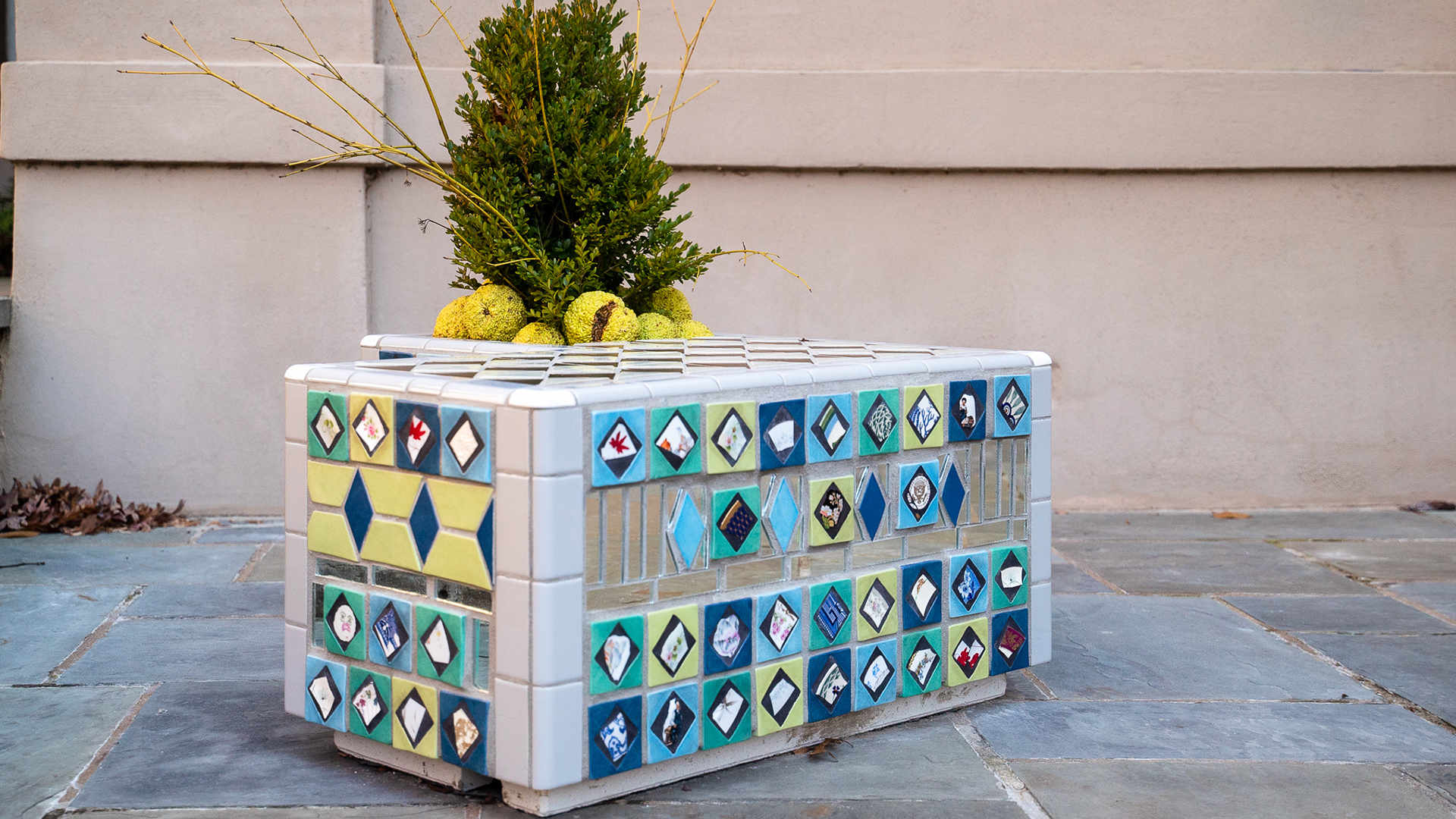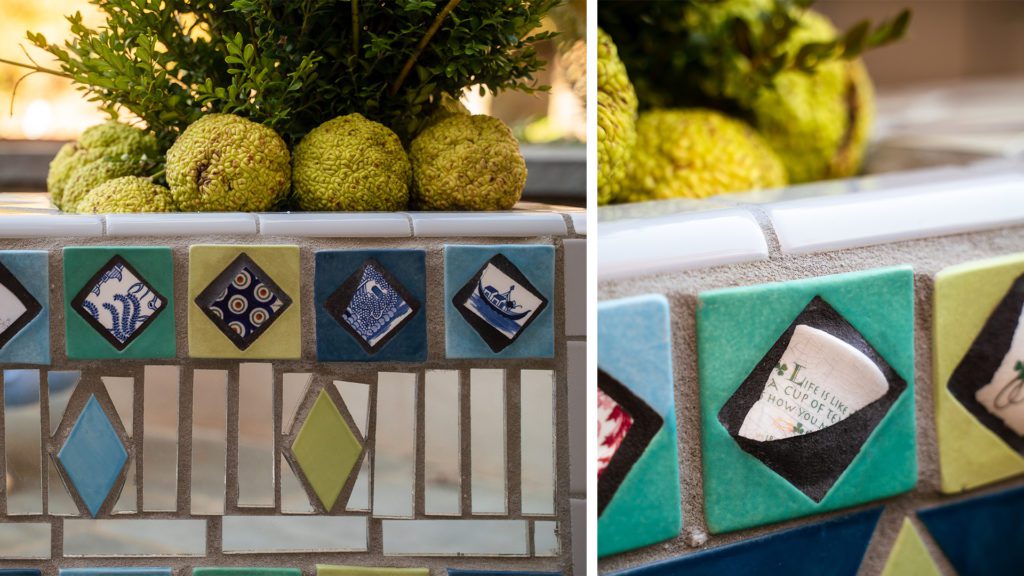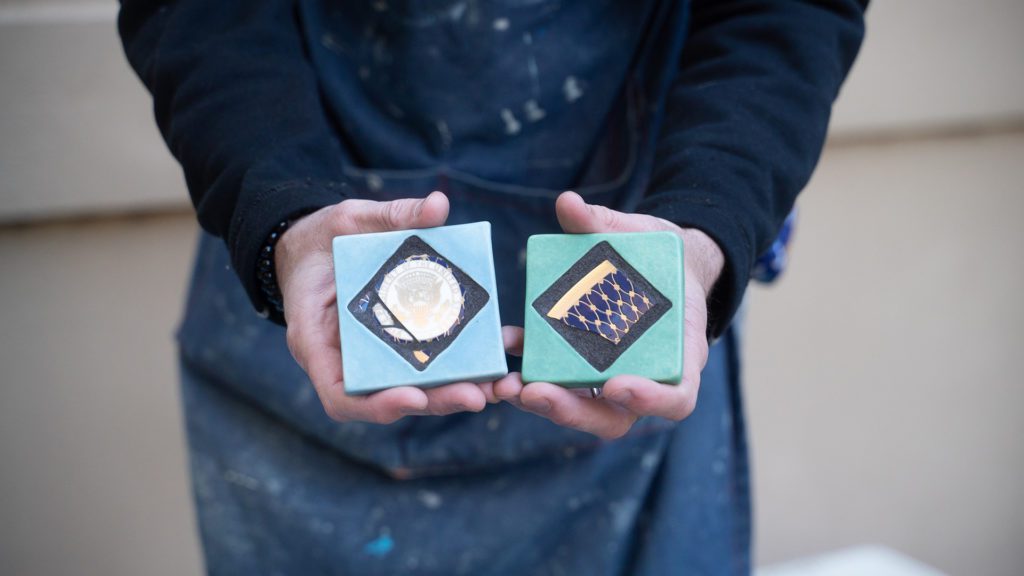
A new outdoor bench at Winterthur connects communities through history, memories, and stories.
When you take a seat on the new, beautifully tiled mosaic bench on the patio of the Galleries Reception Atrium, there is much to reflect on.
There is The Ceiling, a gazebo-like sculpture with a glass roof that is part of Transformations: Contemporary Artists at Winterthur, which represents creator Stefania Urist’s interest in the intersection of people and nature.
There is a section of trunk from the Brown’s Meadow Oak, a 300-year-old tree toppled by a tornado on the estate in 2020. The ancient giant inspired other works by Urist and another Transformations artist, Rob Finn, who painted its portrait in watercolor, a striking memorial to the stately tree.
Then there is the bench itself.
Obviously contemporary, the bench has more connections to Winterthur’s world-class collection of traditional American decorative arts than meets the eye. On closer inspection, one can see references to the Winterthur collection in the many tiles that incorporate bits of ceramic dishware and in the bench design itself, which reflects a continuum of fine craftsmanship and design often associated with the museum objects inside. This is Winterthur reimagined in tile and concrete.
The mosaic bench is part of a new exhibition, Upcycled!, which asks viewers to consider how old things can be reused creatively while also creating a community by working with local nonprofit organizations to make and display works of art. The work of many hands, the bench is an expression of caring that unites Winterthur and project partner Creative Vision Factory with Duffy’s Hope Garden in Wilmington and the New Castle County Hope Center, which provides transitional housing for the homeless. Winterthur’s collaboration with these partners included support and supplies for Creative Vision Factory artists to create benches at Winterthur, Duffy’s Hope Garden, and the Hope Center, as well as support for a tile monument at the Delaware State Hospital’s historic Spiral Cemetery that memorializes more than 700 souls who died in state care without being claimed by family between 1891 and 1983.
At Winterthur, the mosaic tiling on the bench includes fragments of donated dinnerware and other ceramics—even some pieces from Joe and Jill Biden’s vice-presidential home—all associated with the feelings, thoughts, memories, and homes of their donors and the experience of volunteers who made them into something new.

“All of this is about telling the stories of people’s lives, both in the past and the present, and connecting them, often by either using things to remember them by or by thinking about the things that surrounded their lives and what their lives were like,” says Catharine Dann Roeber, interim director of Academic Programs at Winterthur. “For example, the people living at the Delaware State Hospital, what were their lives like? How can we learn from that and improve them?”
The question is especially poignant at Winterthur. A former family home filled with 90,000 historical objects ranging from everyday domestic items to the finest examples of decorative arts, Winterthur co-sponsors two graduate programs with the University of Delaware, one in material culture studies and one in conservation. In both programs, students study, care for, and interpret the belongings and lifeways of people in the past. Every object—a bit of a plate or a fancy piece of furniture—can reveal clues to past lives.
“That scholarship connects to thinking about people who are trying to set up a home in the Hope Center or someplace else, who just need that space to call home to be able to live their lives to the fullest,” Roeber says. “That is totally connected in a really exciting way to the things that we think about in a historical sense here.
“The process of making and craft is something that we study. There is a value not only from the aesthetics of things, but the actual process of making serves a purpose. Each tile has a story to tell.”

Two alumni of the Winterthur/University of Delaware Program in Material Culture, Benét Burton and Molly Mapstone, originated the effort as students by identifying partners in a community art project that would make people aware of Winterthur and strengthen community connections and caring.
They found Michael Kalmbach and Creative Vision Factory, whose mission is to foster the creative potential of individuals on the behavioral health spectrum in a studio art environment that cultivates integration with the local art community through exhibitions, workshops, and communal workspace. Creative Vision Factory in turn identified Friends of the Spiral Cemetery, Duffy’s Hope, and the Hope Center as partners and project sites. It also coordinated workshops where volunteers and clients could create the tiles. Eliza Jarvis and Jonathan Whitney of Flux Creative added additional support and community connections to the project.
“We did what we had hoped to do, create a ripple effect at every stage. It is a beautifully unfolding partnership,” Roeber says. “We’re connecting threads and beginning to set the stage for future collaborations.”
One future collaboration may be the tiling of a tunnel on the Jack Markell Trail that cuts through an extensive Potters Field near the existing Spiral Cemetery, which was disrupted during the construction of route I-295. The murals can bring attention to important history at the site and complement additional endeavors to create a place of memory for those who rest there.